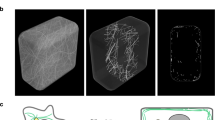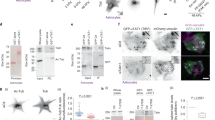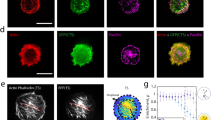Abstract
The rates of mechanochemical processes, such as endocytosis, membrane extension and membrane resealing after cell wounding, are known to be controlled biochemically, through interaction with regulatory proteins. Here, I propose that these rates are also controlled physically, through an apparently continuous adhesion between plasma membrane lipids and cytoskeletal proteins.
This is a preview of subscription content, access via your institution
Access options
Subscribe to this journal
Receive 12 print issues and online access
$189.00 per year
only $15.75 per issue
Buy this article
- Purchase on Springer Link
- Instant access to full article PDF
Prices may be subject to local taxes which are calculated during checkout




Similar content being viewed by others
References
Sheetz, M. P. & Dai, J. Modulation of membrane dynamics and cell motility by membrane tension. Trends Cell Biol. 6, 85–89 (1996).
Raucher, D. & Sheetz, M. P. Membrane expansion increases endocytosis rate during mitosis. J. Cell Biol. 144, 497–506 (1999).
Dai, J., Ting-Beall, H. P. & Sheetz, M. P. The secretion-coupled endocytosis correlates with membrane tension changes in RBL 2H3 cells. J. Gen. Physiol. 110, 1–10 (1997).
Dai, J., Sheetz, M. P. & Morris, C. E. Membrane tension in swelling and shrinking molluscan neurons. J. Neurosci. 18, 6681– 6692 (1998).
Pypaert, M., Mundy, D., Souter, E., Labbe, J. C. & Warren. G. Mitotic cytosol inhibits invagination of coated pits in broken mitotic cells. J. Cell Biol. 114, 1159–1166 (1991).
Machesky, L. M. & Insall, R. H. Signaling to actin dynamics. J. Cell Biol. 146, 267– 272 (1999).
Higgs, H. N. & Pollard, T. D. Activation of Cdc42 and PIP2 of WASP stimulates actin nucleation by Arp2/3 complex. J. Cell. Biol. 150, 1311–1320 ( 2000).
Rohatgi, R., Ho, L. & Kirschner, M. Mechanism of N-wasp activation by CDC 42 and PIP2. J. Cell Biol. 150, 1299–1310 (2000).
Cameron, L. A., Giardini, P. A., Soo, F. S. & Theriot, J. A. Secrets of actin-based motility revealed by a bacterial pathogen. Nature Rev. Mol. Cell Biol. 1, 110– 119 (2000).
Prehoda, K. E., Scott, J. A., Dyche Mullins, R. & Lim, W.A. Integration of multiple signals through cooperative regulation of the N-wasp–Arp 2/3 complex. Science 290, 801– 806 (2000).
Chen, F. et al. Cdc42 is required for PIP2-induced actin polymerization and early development but not for cell viability. Curr. Biol. 10, 758–765 (2000).
Sormunen, R. & Lehto, V. P. Spectrin in the leading lamella of cultured chicken fibroblasts. Eur. J. Cell Biol. 68, 387–397 (1995).
Mogilner, A. & Oster, G. Cell motility driven by actin polymerization . Biophys. J. 71, 3030– 3045 (1996).
Raucher, D. & Sheetz, M. P. Cell spreading is regulated by membrane tension. J. Cell Biol. 148, 127 –136 (2000).
Steinhardt, R. A., Bi, G.-Q. & Alderton, J. M. Cell membrane resealing by a vesicular mechanism similar to neurotransmitter release. Science 263, 390–393 (1994).
Bi, G. Q., Alderton, J. M. & Steinhardt, R. A. Calcium-regulated exocytosis is required for cell membrane resealing. J. Cell Biol. 131, 1747 –1758 (1995).
Terasaki, M., Miyake, K. & McNeil, P. L. Large plasma membrane disruptions are rapidly resealed by Ca2+-dependent vesicle–vesicle fusion events. J. Cell Biol. 139, 63–74 (1997).
Togo, T., Alderton, J. M., Bi, G.-Q. & Steinhardt, R. A. The mechanism of facilitated cell membrane resealing. J. Cell Sci. 112, 719–731 ( 1999).
Togo, T., Krasieva, T. B. & Steinhardt, R. A. A decrease in membrane tension precedes successful cell membrane repair. Mol. Biol. Cell 11, 4339–4346 (2000).
Dai, J. & Sheetz, M. P. Mechanical properties of neuronal growth cone membranes studied by tether formation with laser optical tweezers . Biophys. J. 68, 988–996 (1995).
Evans, E. Microscopic-physical determinants in biological adhesion. Blood Cells 19, 401–419 ( 1993).
Raucher, D. et al. Phosphatidylinositol-4,5-bisphosphate functions as a second messenger that regulates cytoskeleton-plasma membrane adhesion. Cell 100, 221–228 ( 2000).
Berk, D. A. & Hochmuth, R. M. Lateral mobility of integral proteins in red blood cell tethers. Biophys. J. 61, 9–18 (1992).
Dai, J. & Sheetz, M. P. Membrane tether formation from blebbing cells. Biophys. J. 77, 3363– 3370 (1999).
Keller, H. & Eggli, P. Protrusive activity, cytoplasmic compartmentalization, and restriction rings in locomoting, blebbing Walker carcinosarcoma cells are related to detachment of cortical ac193. Cell Motil. Cytoskeleton 41, 181–193 ( 1998).
Cunningham, C. C. Actin polymerization and intracellular solvent flow in cell surface blebbing . J. Cell Biol. 129, 1589– 1599 (1995).
Edidin, M., Zuniga, M. C. & Sheetz, M. P. Truncation mutants define and locate cytoplasmic barriers to lateral mobility of membrane glycoproteins. Proc. Natl Acad. Sci. USA 91, 3378–3382 (1994).
Janmey, P.A., Xian, W. & Flanagan, L. A. Controlling cytoskeleton structure by phosphoinositide–protein interactions: phosphoinositide binding protein domains and effects of lipid packing. Chem. Phys. Lipids 101, 93– 107 (1999).
Wang, J., Arbuzova, A., Hangyas-Mihalyne, G. & McLaughlin, S. The effector domain of myristoylated alanine-rich C kinase substrate (MARCKS) binds strongly to phosphatidylinositol 4,5-bisphosphate (PIP2) . J. Biol. Chem. (in the press).
O'Toole, P. J., Wolfe, C., Ladha, S. & Cherry, R. J. Rapid diffusion of spectrin bound to a lipid surface. Biochim. Biophys. Acta 1419, 64–70 (1999).
Bouchard, M. et al. Interaction between G-actin and various types of liposomes: A 19F, 31P, and 2H nuclear magnetic resonance study. Biochemistry 37, 3149– 3155 (1998).
Niebuhr, K. et al. IpgD, a protein secreted by the type III secretion machinery of Shigella flexneri, is chaperoned by IpgE and implicated in entry focus formation. Mol. Microbiol. 38, 8– 19 (2000).
Lanier, L. M. & Gertler, F. B. Actin cytoskeleton: thinking globally, actin' locally. Curr. Biol. 10, R655–R657 (2000).
Sheetz, M. P. Glycoprotein motility and dynamic domains in fluid plasma membranes. Annu. Rev. Biophys. Biomol. Struct. 22, 417– 431 (1993).
Apgar, J. R. Activation of protein kinase C in rat basophilic leukemia cells stimulates increased production of phosphatidylinositol 4-phosphate and phosphatidylinositol 4,5-bisphosphate: correlation with actin polymerization. Mol. Biol. Cell 6, 97–108 ( 1995).
Kell, A. & Glaser, R. W. On the mechanical and dynamic properties of plant cell membranes: their role in growth, direct gene transfer and protoplast fusion. J. Theor. Biol. 160, 41–62 (1993).
Morris, C. E. & Homann, N. Cell surface area regulation and membrane tension. J. Membr. Biol. 179, 79 –102 (2001).
Herring, T. L., Cohan, C. S., Welnhofer, E. A., Mills, L. R. & Morris, C. E. F-actin at newly invaginated membrane in neurons: implications for surface area regulation. J. Membr. Biol. 171, 151–169 ( 1999).
Hochmuth, R. M., Shao, J. Y., Dai, J. & Sheetz, M. P. Deformation and flow of membrane into tethers extracted from neuronal growth cones. Biophys. J. 70, 358–369 (1996).
Raucher, D. & Sheetz, M. P. Characteristics of a membrane reservoir buffering membrane tension. Biophys. J. 77 , 1992–2002 (1999).
Author information
Authors and Affiliations
Related links
Related links
DATABASE LINKS
FURTHER INFORMATION
Rights and permissions
About this article
Cite this article
Sheetz, M. Cell control by membrane–cytoskeleton adhesion . Nat Rev Mol Cell Biol 2, 392–396 (2001). https://doi.org/10.1038/35073095
Issue Date:
DOI: https://doi.org/10.1038/35073095
This article is cited by
-
SAMHD1-induced endosomal FAK signaling promotes human renal clear cell carcinoma metastasis by activating Rac1-mediated lamellipodia protrusion
Experimental & Molecular Medicine (2023)
-
Stepwise membrane binding of extended synaptotagmins revealed by optical tweezers
Nature Chemical Biology (2022)
-
Interplay between mechanics and signalling in regulating cell fate
Nature Reviews Molecular Cell Biology (2022)
-
The Indigenous Volatile Inhibitor 2-Methyl-2-butene Impacts Biofilm Formation and Interspecies Interaction of the Pathogenic Mucorale Rhizopus arrhizus
Microbial Ecology (2022)
-
Homeostatic membrane tension constrains cancer cell dissemination by counteracting BAR protein assembly
Nature Communications (2021)



